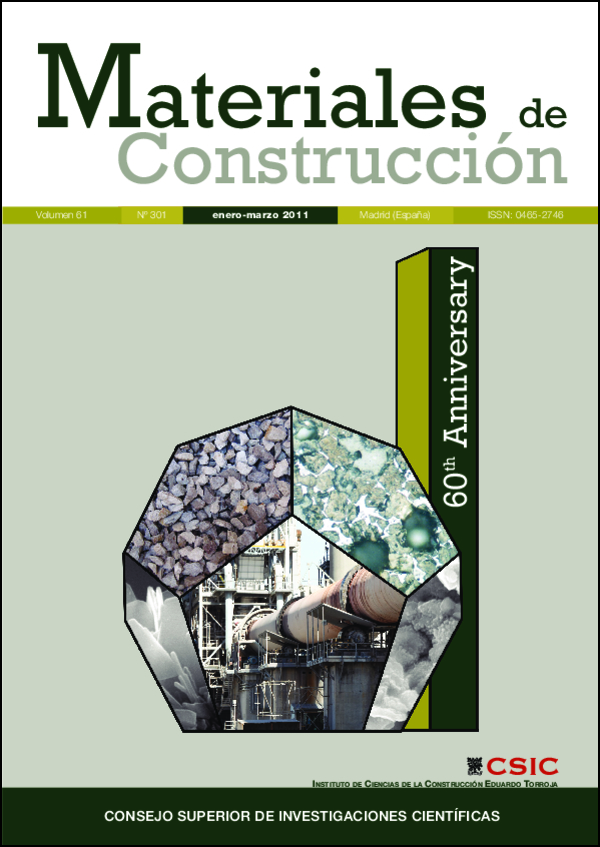Mechanical properties of hot bituminous mixes manufactured with recycled aggregate of Silestone® waste
DOI:
https://doi.org/10.3989/mc.2011.52709Keywords:
waste recycling, bituminous mixes, mechanical properties, recycled aggregatesAbstract
This article presents the results of a research project which analyzes the viability of incorporating waste material from decorative quartz solid surfacing in the manufacture of hot bituminous mixes. For this purpose, various bituminous mixes were manufactured with waste aggregate in different percentage. A set of tests were carried out that permitted the characterization of the mechanical behavior of these mixes. The results of these tests were similar to the results obtained when conventional mixes made from virgin quarry aggregate were tested. The results for moisture sensitivity as well as for wheel track rutting on mixes showed the optimal performance of this waste material even under very demanding traffic conditions. Laboratory studies showed that the use of this waste material in the manufacture of bituminous mixes is technically viable and can provide high-quality recycled aggregates at a very low cost, which can be used in the pavement of road.
Downloads
References
(1) “Ley 10/1998, de 21 de abril, de Residuos”, BOE, nº 96 (1998).
(2) Ministerio de Medio Ambiente: “Plan Nacional de Residuos Integrados 2007-2015”.
(3) Parlamento Europeo: “Directiva Marco 98/2008/CE de Residuos”, junio de 2008.
(4) Pérez, I.; Toledano, M.; Gallego, J.; Taibo, J.: “Mechanical proprieties of hot mix asphalt made with recycled aggregates from reclaimed construction and demolition debris”, Mater. Construcc., 2007, vol. 57, 285, 17-29.
(5) Akbulut, H.; Güer, C.: “Use of aggregates produced from marble quarry waste in asphalt pavements”. Building and Environment, 2007, vol. 42, 5, 1921-1930. doi:10.1016/j.buildenv.2006.03.012
(6) Bairagi, N. K.; Vidyadhara, H. S.; Ravande K.: “Mix desing procedure for recycled aggregate concrete”, Construction and Building Materials, 1990, vol. 42, 4, 188-193. doi:10.1016/0950-0618(90)90039-4
(7) De Rezende, R. L.; De Carvalho, J. C.: “The use of quarry waste in pavement construction”. Resources, Conservation and Recycling, 2003, vol. 39, 91-105. doi:10.1016/S0921-3449(02)00123-4
(8) Snyder, M. B.: “Use of crushed concrete products in Minnesota pavement foundations”. Minnesota Departament of Tranportation, St. Paul, MN, 1995.
(9) Çetin, A.: “Assessment of industrial wastes on asphalt concrete pavement mixtures”. M Sc Thesis, Anadolu University, Natural Science Institute, Departament of Civil Engineering, Eskisehir, 1997 (In Turkish).
(10) Grupo Cosentino S.A., www.silestone.com
(11) Dirección General de Carreteras: “Pliego de Prescripciones Técnicas Generales para Obras de Carreteras y Puentes PG-3”, Ministerio de Fomento, Ediciones Liteam, Madrid, 2004.
(12) Gordillo, J.: “Panorama general de las mezclas bituminosas”, Jornada sobre caracterización y control de calidad de mezclas bituminosas, Sevilla, 2001.
(13) Dirección General de Carreteras: “Normas NLT. Ensayos de Carreteras”, Ministerio de Obras Públicas y Transportes (MOPT), 2ª edición, Madrid, 1992.
(14) Asociación Española de Normalización y Certificación (AENOR): “Manual de normas técnicas UNE-EN”, Serie Construcción, Áridos para mezclas bituminosas y tratamientos superficiales de carreteras, Madrid, 2001, p. 526.
Downloads
Published
How to Cite
Issue
Section
License
Copyright (c) 2011 Consejo Superior de Investigaciones Científicas (CSIC)

This work is licensed under a Creative Commons Attribution 4.0 International License.
© CSIC. Manuscripts published in both the printed and online versions of this Journal are the property of Consejo Superior de Investigaciones Científicas, and quoting this source is a requirement for any partial or full reproduction.All contents of this electronic edition, except where otherwise noted, are distributed under a “Creative Commons Attribution 4.0 International” (CC BY 4.0) License. You may read here the basic information and the legal text of the license. The indication of the CC BY 4.0 License must be expressly stated in this way when necessary.
Self-archiving in repositories, personal webpages or similar, of any version other than the published by the Editor, is not allowed.
















